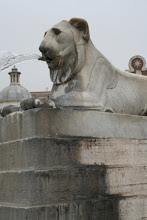What to do when it’s raining in Rome? Head underground.
The streets have been awash the last few days – it hasn’t
rained all that heavily, but it has rained consistently, which means any time
spent walking in the open results in sodden shoes, wet clothes and minimum
photo opportunities. I mean, who wants
to take photos from under a dripping umbrella?
.jpg) |
| Looking towards the Palazzo Farnese, raining |
Wet weather is a great opportunity to explore the Rome that
lies underneath the surface. It’s
certainly drier, and at this time of the year there’s also the likelihood of
having any underground site to oneself.
At least, that’s been my experience over the last few days.
A little further along from my apartment in Piazza San
Egidio is the Church of San Crisogono, built in the 4th century and,
as is usual here in Rome, built again – over the existing structure – in the 12th
century. As Christianity in the 4th
century was off to a shaky start under the Emperor Constantine, churches
consecrated at that time began as private houses and were converted to public
places of worship. So, through a heavy
door (that was shut behind me as I descended - quite disconcerting) it is
possible to descend a spiral staircase to find the rounded form of the 4th
century apse, with a shrine to the martyr Saint Crysogonus in the centre.
 |
| San Crisogono apse |
As I’m finding with all multi-level churches, the lower
structures can be quite difficult to distinguish, as foundations to support the
upper churches have altered the structure and symmetry of the earlier
buildings. It was tricky to explore the
lower church of San Crisogono and make out where the church ended and where the
remains of the private houses began.
Here and there sarcophagi were dotted about –from an intricate marble
sarcophagus from the 2nd century with maritime themes, to some
smaller terracotta sarcophagi below frescoes, now heavily faded and almost undiscernible,
from the 6th century.
 |
| San Crisogono sarcophagus |
I have to say, it was very spooky down in the depths of San
Crisogono. The structure twisted and
turned, and I had this horrible feeling I’d get lost in the maze and be unable
to find my way out. Thankfully, in the
murk and gloom I did relocate the iron stair and made my way up into the modern
church without any grief. And very
pleasant it was, too, to stand in the middle aisle of the church and hear the
roar of traffic, and see daylight outside.
A little further along, and escaping today’s rain, I made my
way over to San Nicola in Carcere, another church which hides ancient structures
underneath. In this case, however, those
structures are three Roman pagan temples from the Republican era: the earliest being the Temple of Janus
Bifrons from 260 B.C. Under the altar,
marble steps lead to a vaulted crypt, and sharply to the left, a narrow arch
leads to the first of the three temples, with walls of solid tufa blocks. I’m
particularly fascinated by legends associated with the middle temple, to the
mother queen Juno Sospita, in which annual offerings were made by virgins to
the holy snakes bred in a cave by her shrine.
Any refusal of the food by the serpents was considered a bad omen and
required the girl’s sacrifice. What an
incentive to make those offerings palatable..
.jpg) |
| San Nicola middle Temple |
The exterior of San Nicola is surprising, too, in that it
was constructed around the ruins of a Roman forum, with columns from ancient
sites incorporated into the façade of the church.
.jpg) |
| San Nicola exterior with Forum columns |

And I take it, the "Holy" snakes have gone... ! Don't quite get the virgin offerings. Were they the "offering" and if not eaten, were sacrificed? With options like that, I'd imagine they were hard to find.... ;-). xxx
ReplyDeleteI think they offered food irresistable to snakes (honey coated mice?), and any signs of disatisfaction meant "off with her head". Just like Lil, really ;-) xxx
Delete